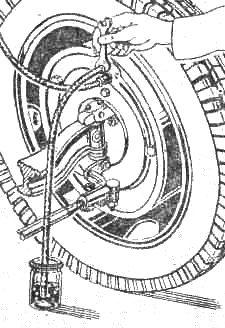
Cleaning and filling the brake system
Content
Kawasaki ZX6R 636 model 2002 sports car restoration saga: 23rd series
Cleaning the brake system
Unlike a brake fluid refresh / change operation, which involves being very careful not to insert an air bubble into the brake system, purging the brake system boils down to emptying the brake fluid can.
Cleaning begins. The open brake can is almost empty, I have already evacuated a lot of fluid.
I open the master cylinder casserole, taking care not to tip it over. I even put the Sopalin around the specified casserole, finally, rather around the can. I hold everything with an elastic band. Otgoons know you can wear a sock, at least a tennis headband around the can if it's round. This usually applies to athletes as well as mine.
Why this precaution?
I wouldn't want to attack the top fork tee paint that I redid with the rest of the beautiful quality black paint. You never know. Well, yes, I know: I'm embarrassed ... The liquid doesn't look too bad, but it is also unclear. However, I am devastating everything! At the very least, this may mean that the stirrups are also okay.
Durite, the container that holds it in place and everything goes well!
If I emptied the chain in a community garage using the equipment on site, I later opted for a commercially available liquid receiver for less than € 9 including hose and can. It has a magnet and a small hook. Two hoses are a plus for cleaning two calipers at the same time. I open the bleed screw and start pumping with the brake lever. Once Shadok, Shadok always!
Once the brake is dry, this time I'll put the absorbent paper directly into the brake can. There is always a chink in the hoses. I will have to dismantle the banjo on the base, at the yoke level and on the casserole. The puff is strong, but everything is going well. As with the top, I protect and repair the brake screws even if I have one with my new kit. This is where the rigid connection between the small hose and the can is removed. By the way, I could change it, it is retail as well as the jar. But no.
Filling the brake system
I don't do it right away, but I still give a trick to fill his front brake system. The device and precautions are identical. What's changing? We'll have to be flexible if we want to do it ourselves. There are a few things to note about chain pressure. On the one hand, to the balance of flow between the hoses. In this case, I have two separate ones, and I also have two hoses on the receiver, so it's simple. This time it is not accepted.
On the other hand, I will have to fill the can completely, activate the brake lever, close the bleed screws on the calipers, lower the fluid, release the lever, brake, loosen the bleed screws, let the fluid run, and so on. We brake, open, close, release, open, brake, etc., making sure that the fluid level in the brake receiver is always at the right level so as not to catch air in the hoses. We are the ones who know that we will end up when we no longer see the bubble passing through the transparent hoses, leading to the container receiving an "excess" of brake fluid.
Precisely because this operation is tedious, especially done alone, there are brake check valves or check valve screws.
We no longer need to worry about constantly closing, just to keep an eye out for bubbles and especially their absence. On the other hand, pay attention to the quality of what you take: any leak or loss of pressure would be a bad investment.
Regards, if you clean your circle often, the investment of about 10 euros is worth it! Since brake fluid is not only hydrophilic (it absorbs water from the surrounding air), it loses its properties over time, whether in a can or in a can. Upgrading is often a good idea if you travel a lot, even more so if you do not travel much.
This is why it should be changed no later than every two years in the manufacturer's maintenance guidelines.
Remember
- Air is the enemy of brake fluid, whether in hoses or in contact with a locked one.
- Regular cleaning is a guarantee that braking is at the top.
- Monitoring the fluid level in the can is a guarantee of good braking.
Not to do
- Too much brake jar filling. Too much pressure and heat can burst hoses or cause leaks.
- It is not enough to fill the brake can. Air can enter the brake system and render it ineffective. Best case scenario.
Tools:
- Key blade, reasonable capacity container, hoses
Deliveries:
- What to rub is enough to rinse (water)
